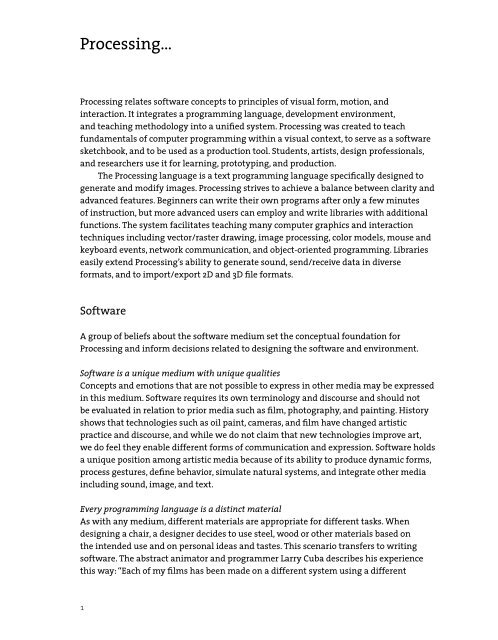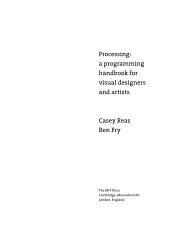Fractal.Invaders, Substrate (Interview with Jared Tarbell) - Processing
Fractal.Invaders, Substrate (Interview with Jared Tarbell) - Processing
Fractal.Invaders, Substrate (Interview with Jared Tarbell) - Processing
You also want an ePaper? Increase the reach of your titles
YUMPU automatically turns print PDFs into web optimized ePapers that Google loves.
<strong>Processing</strong>…<br />
<strong>Processing</strong> relates software concepts to principles of visual form, motion, and<br />
interaction. It integrates a programming language, development environment,<br />
and teaching methodology into a unifi ed system. <strong>Processing</strong> was created to teach<br />
fundamentals of computer programming <strong>with</strong>in a visual context, to serve as a software<br />
sketchbook, and to be used as a production tool. Students, artists, design professionals,<br />
and researchers use it for learning, prototyping, and production.<br />
The <strong>Processing</strong> language is a text programming language specifi cally designed to<br />
generate and modify images. <strong>Processing</strong> strives to achieve a balance between clarity and<br />
advanced features. Beginners can write their own programs after only a few minutes<br />
of instruction, but more advanced users can employ and write libraries <strong>with</strong> additional<br />
functions. The system facilitates teaching many computer graphics and interaction<br />
techniques including vector/raster drawing, image processing, color models, mouse and<br />
keyboard events, network communication, and object-oriented programming. Libraries<br />
easily extend <strong>Processing</strong>’s ability to generate sound, send/receive data in diverse<br />
formats, and to import/export 2D and 3D fi le formats.<br />
Software<br />
A group of beliefs about the software medium set the conceptual foundation for<br />
<strong>Processing</strong> and inform decisions related to designing the software and environment.<br />
Software is a unique medium <strong>with</strong> unique qualities<br />
Concepts and emotions that are not possible to express in other media may be expressed<br />
in this medium. Software requires its own terminology and discourse and should not<br />
be evaluated in relation to prior media such as fi lm, photography, and painting. History<br />
shows that technologies such as oil paint, cameras, and fi lm have changed artistic<br />
practice and discourse, and while we do not claim that new technologies improve art,<br />
we do feel they enable different forms of communication and expression. Software holds<br />
a unique position among artistic media because of its ability to produce dynamic forms,<br />
process gestures, defi ne behavior, simulate natural systems, and integrate other media<br />
including sound, image, and text.<br />
Every programming language is a distinct material<br />
As <strong>with</strong> any medium, different materials are appropriate for different tasks. When<br />
designing a chair, a designer decides to use steel, wood or other materials based on<br />
the intended use and on personal ideas and tastes. This scenario transfers to writing<br />
software. The abstract animator and programmer Larry Cuba describes his experience<br />
this way: “Each of my fi lms has been made on a different system using a different<br />
1



